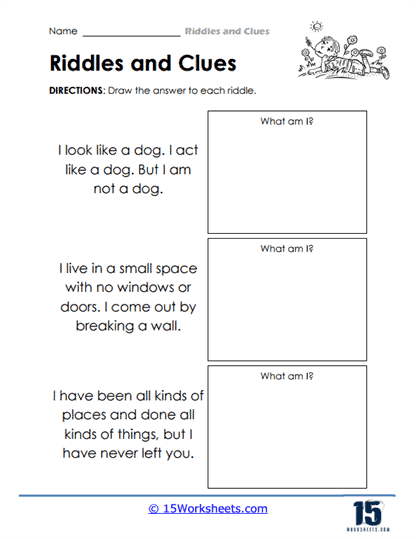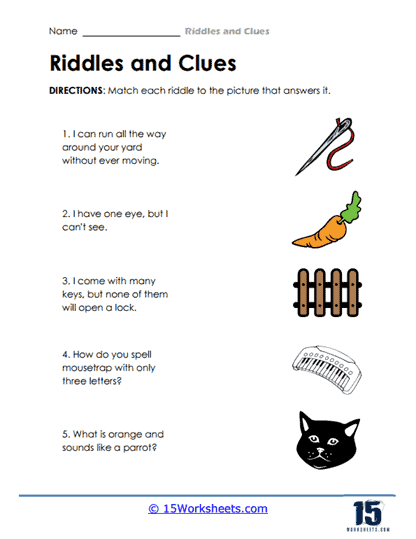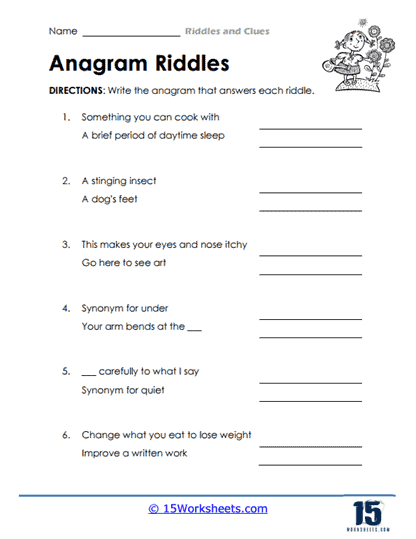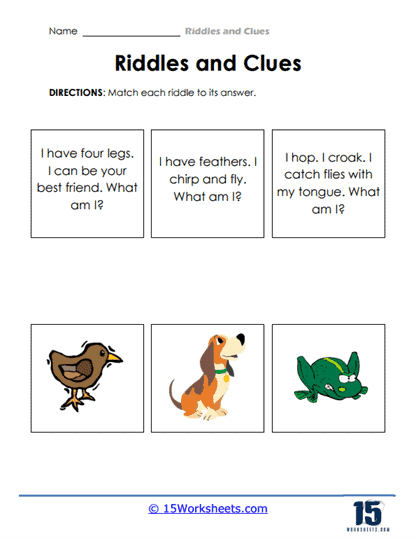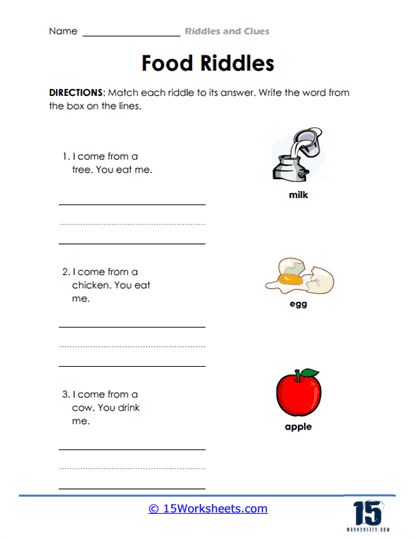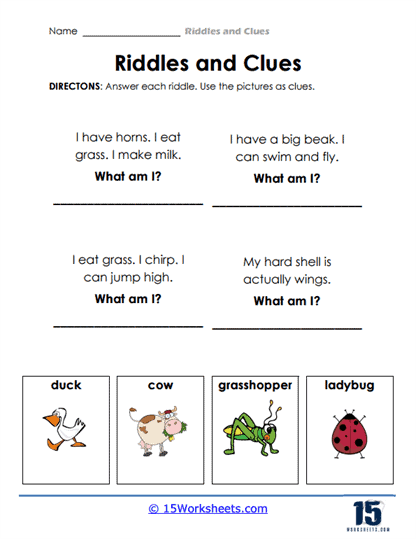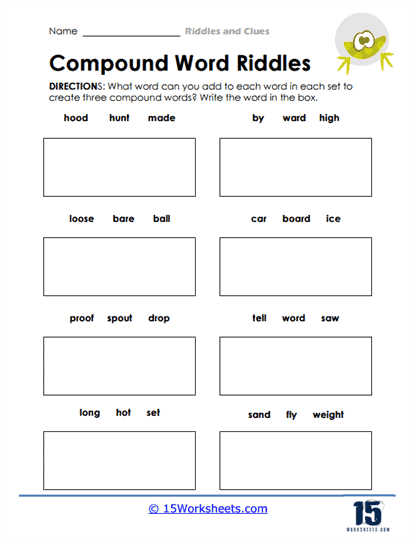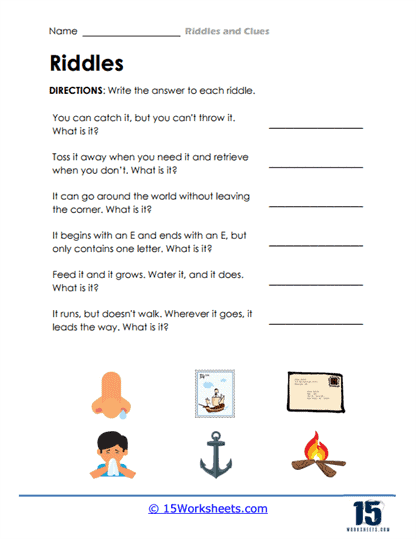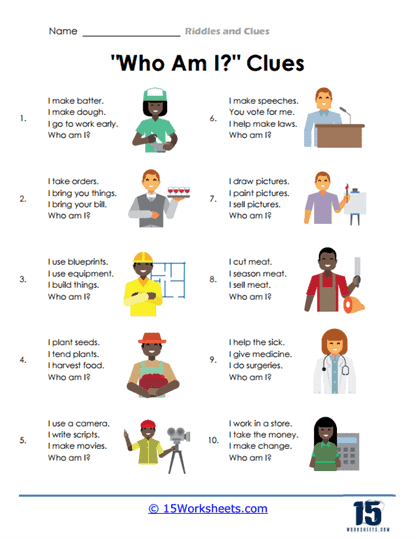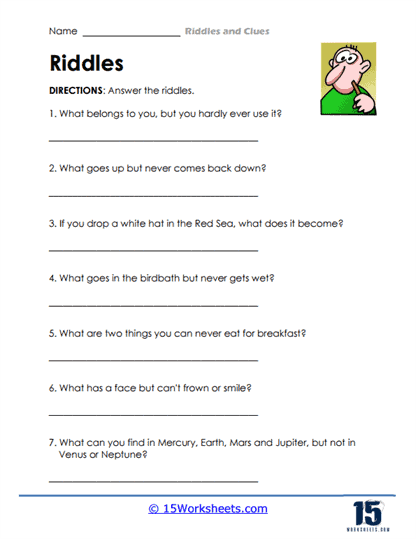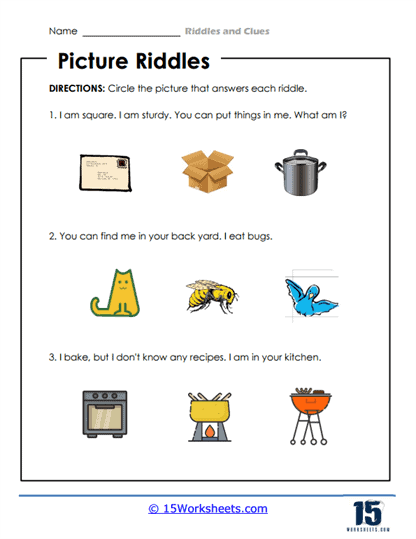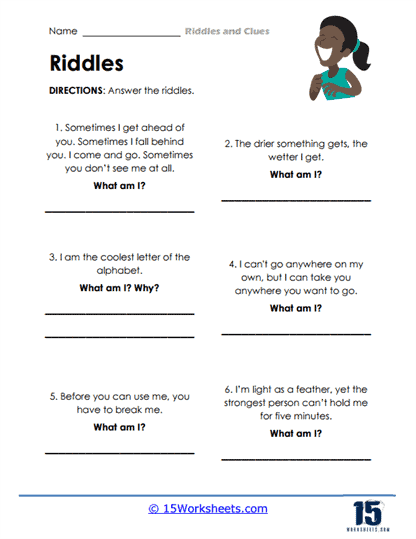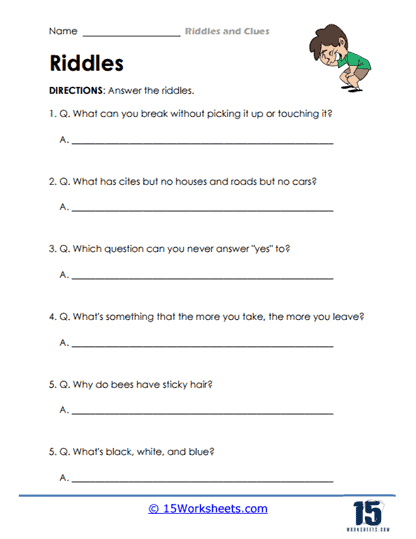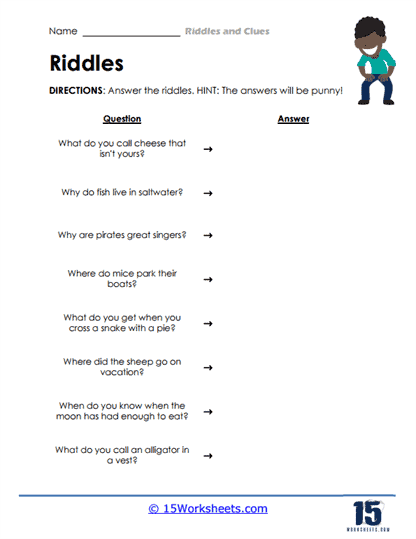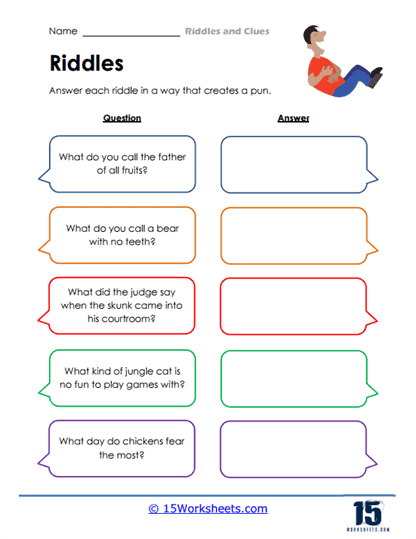Riddles and Clues Worksheets
All About These 15 Worksheets
In today’s fast-paced, information-driven world, the ability to think critically and solve problems creatively is more important than ever. It’s not just about knowing the right answer; it’s about the process of getting there, the journey of analysis, deduction, and lateral thinking. The “Riddles and Clues” worksheet series is designed precisely with these goals in mind, offering a collection of 15 thoughtfully curated activities that challenge students to stretch their cognitive abilities. These worksheets are not mere puzzles; they are tools for building the intellectual framework that students will need in all aspects of life-whether in school, in their future careers, or in everyday decision-making.
The power of riddles lies in their simplicity. At first glance, they may seem like a playful diversion, but beneath the surface, they hold a treasure trove of learning opportunities. Each riddle and clue demands that students step outside their usual way of thinking and embrace creative reasoning. This is the essence of “thinking outside the box.” In a world where so much is presented directly, riddles encourage students to dig deeper, to look for hidden meanings, and to make connections that are not immediately obvious. This process of discovery fosters a mindset that is not only inquisitive but also resilient, as students learn to approach problems from different angles and persist in their search for solutions.
One of the key strengths of these worksheets is the range of difficulty they present. The riddles start with simpler, more accessible challenges, gradually building in complexity. This progression is essential for developing both confidence and competence in problem-solving. Students are given the opportunity to experience the satisfaction of solving easier riddles, which motivates them to tackle more difficult ones. As the difficulty increases, so too does the demand on their cognitive abilities, pushing them to refine their deductive reasoning and analytical skills. By the time students reach the more complex puzzles, they have already built a foundation of logical thinking that allows them to face these challenges with greater ease and effectiveness.
More than just a fun brain exercise, these worksheets also have profound educational benefits. For instance, working through riddles helps students enhance their deductive reasoning skills-an ability crucial to subjects like math, science, and even literature. Deductive reasoning requires students to start with known facts and work systematically to uncover the answer, a process mirrored in scientific inquiry and mathematical proofs. But it’s not just about numbers and logic. These worksheets also tap into linguistic creativity, pushing students to think critically about wordplay, metaphors, and associations. As they decipher the clever twists of language embedded in the riddles, they develop a deeper appreciation for how language can convey multiple meanings-a skill that enriches both their reading and writing abilities.
Beyond academics, these activities nurture a sense of curiosity, one of the most important traits for lifelong learning. Riddles captivate the imagination. They present students with a mystery that begs to be solved, stimulating their natural desire to learn and understand the world around them. This sense of curiosity extends far beyond the confines of the worksheet. It encourages students to approach all kinds of problems with an open mind and an eagerness to explore. Curiosity drives innovation, and by engaging students in riddles, we’re nurturing the very mindset that will inspire future inventors, scientists, and leaders.
The process of solving riddles also strengthens cognitive flexibility, the ability to adapt one’s thinking to new and unexpected situations. This skill is essential in our ever-changing world, where students will need to navigate complex, unpredictable challenges in both their personal and professional lives. Cognitive flexibility allows students to switch between different perspectives, consider alternative solutions, and remain open to new ideas. The riddles in these worksheets force students to abandon rigid thought patterns and embrace new ways of thinking-whether that means interpreting a clue in a non-literal way or breaking down a problem into smaller, more manageable parts.
Equally important is the role these worksheets play in fostering perseverance. Some riddles are intentionally tricky, requiring multiple attempts and a great deal of patience to solve. Students learn that it’s okay not to get the answer right away-that sometimes, the best solutions come only after multiple rounds of trial and error. This teaches them an invaluable lesson about the nature of problem-solving: it’s not just about getting the right answer, but about the persistence and creativity it takes to get there. These are skills that will serve them well in every area of their lives.
The Best Way to Solve a Riddle
Riddles are as old as time. Since they’re a fun way of working your brain, they’ve passed the tests of time and continue to be an engaging party trick. Many people are fascinated with how imaginative a riddle can be, but riddles have evolved drastically. In today’s day and age, riddles rely mostly on double-meaning and wordplay.
Without having some skill and a lot of thinking, solving one can be difficult. However, some ways of solving riddles may prove to be more effective than several others. Read on as we take you through the best way to solve a riddle.
Solving a Riddle: A Fool-Proof Process
1. Acknowledging the Trickery
The most crucial aspect you need to remember while solving a riddle is that it’s supposed to trick you. When you have that in mind, start looking for any misleading language clues or words that may have a double meaning. Throughout this process, you must guard your conscious from any assumptions.
A riddle will be made up of a few lines in most cases. One way of simplifying the process is to break a riddle down into a manageable chunk.
2. Focus on Every Element
Now that you’ve divided the clues or the different parts of the riddle, you have to focus on every part individually. Can you come up with any potential answers? In several instances, a riddle may have a misleading clue that is supposed to look like a clue when it’s only there to waste your time.
Consider this example: What can always run but is never able to walk?
One of the most puzzling aspects of a riddle is its ability to give human characteristics to an inanimate object. That’s what’s going to happen here, too. Whenever you hear the words run or walk, you instantly start thinking of an animal or a person.
But this is when you start focusing on the first rule. Wouldn’t the answer be too obvious if the answer was an animal or a person? Think about the two clues you have. With some aggressive brainstorming, it may come to your mind that the riddle is talking about an object.
The electronics that we use can run, but they can’t walk. Water can run, too, but it can’t walk either. This is why you need to dissect every keyword.
3. Accepting That There is No “Right” Solution
While riddles that have words can be tricky, riddles with numbers can be a nightmare for several people. The critical thing to remember amidst this process is that there is no definite way to know if you’ve solved a riddle the right way. A riddle that’s supposed to be “math-intensive” isn’t too heavily focused on the numbers. Once again, you’ll have to read between the lines to make sense of the question being asked.
While it may sound cliched, thinking outside the box is essential. The sole reason riddles make you work your brain is because they’re supposed to be solved with a distinct thought process. One that we don’t adopt on a daily.
Solving a riddle becomes easier once you stop walking on the traditional pathway, solving a riddle becomes easier.

